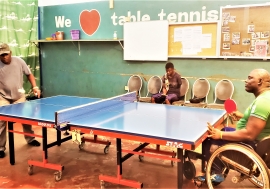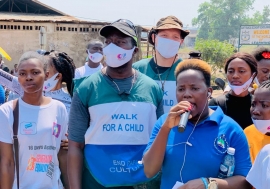In September 2021, the United Nations General Assembly adopted a resolution proclaiming the Second Decade of Action for Road Safety 2021-2030, with the ambitious target of preventing at least 50 percent of road traffic deaths and injuries by 2030. Jean Todt, a former director of Ferrari Formula One, is the United Nations Secretary-General’s Special Envoy for Road Safety. Before launching the UN worldwide campaign #MakeASafetyStatement in New York on 1 July, in partnership with JCDecaux, a global leader in outdoor advertising, Mr. Todt visited Sierra Leone. There, he spoke with the UN’s Osman Benk Sankoh, about how Africa can achieve the 2030 road safety targets. These are excerpts from the interview.

How would you describe the current state of road safety in Africa?
Africa is the most affected by road crashes, with a traffic fatality rate of 19.5 deaths per 100,000 people compared to 16 deaths per 100,000 in Southeast Asia, and 6.5 deaths per 100,000 in Europe, according to the WHO Global Status Report on Road Safety 2023.
Road crashes are also the world’s leading cause of death for children and young adults aged 5-29 years. We know that Africa has the youngest population in the world, with 70 percent of sub-Saharan Africa under the age of 30. This demonstrates the magnitude of the challenge.
Beyond the human tragedy, road crashes also slow down the development of a country, costing on average 4-5 percent of GDP. In Africa, the percentage could be higher.
In which areas do you think African countries have made progress and where do they need to improve?
We see progress with the African Integrated High-Speed Railway Network, which is part of the AU Agenda 2063 and designed to connect African capitals, economic and other industrial hubs, as well as major tourism locations with high-speed rail, electricity, and ICT broadband infrastructure and services.
Senegal’s Bus Rapid Transit, supported by the UN Environment Programme, will connect communes in Dakar. The 150-seater buses are set to carry some 300,000 passengers a day and will decongest the city for safer and greener travel.
Cameroon, the Democratic Republic of the Congo, and Uganda are beneficiaries of the United Nations Road Safety Fund project on safer and cleaner used cars in Africa, promoting regulations on the export and import of used vehicles in Africa, leading to safety, health, climate, and economic benefits.
Not wearing a helmet is one of the main causes of fatalities and serious injuries on the road in Africa. The project “Helmet for Hope” that I support can be a game changer in Africa. Motorbikes are rising in popularity. Wearing a helmet reduces the risk of road fatalities by 42 percent and injuries by 69 percent. Countries like Rwanda are promoting the initiative for every rider and passenger.
How does road safety tie into the broader SDGs?
Road safety targets are integral to the SDG agenda. SDG 3.6 aims to halve road traffic deaths and injuries by 2030, while SDG 11.2 focuses on providing access to safe, affordable, accessible, and sustainable transport systems and improving road safety for all.
Furthermore, road safety is essential to achieving the goals related to health, climate change, infrastructure and cities, education, gender equality, decent work, and economic growth. For example, with SDG 4, safer roads mean more children and young people will have safe access to quality education.
The goal to halve road accidents by 2030 is ambitious. What are the most effective policies and infrastructure requirements to achieve this target?
Indeed, the goal is ambitious. The last WHO Global Status Report on Road Safety states that only 10 countries have so far successfully reduced road traffic deaths by over 50 percent. So, we need to increase our efforts. With that in mind, the UN General Assembly on 24 June 2024 adopted a resolution on improving road safety, ahead of the Fourth Global Ministerial Conference on Road Safety to be held in Marrakesh from 18 to 20 February 2025.
There are 58 United Nations transport conventions, of which six are considered priorities for accession for improving road safety.
For example, focusing on making walking and cycling safer is a game changer. Fewer than 50 countries have policies that promote walking, cycling, and public transport. Vulnerable road users such as pedestrians, cyclists, and motorcyclists remain dangerously exposed.
You have mentioned the need for collaboration between Presidents Bio of Sierra Leone and Paul Kagame of Rwanda on road safety. Can you elaborate on this initiative?
I encouraged President Bio to collaborate with his Rwandan counterpart, President Kagame, and other African leaders to prioritize road safety at the AU in their pursuit of 'The Africa We Want.' Agenda 2063’s second 10-year plan, spanning 2024 to 2033, will help achieve the goal of halving the number of road traffic deaths by 2030.
I would also encourage coordination among African countries on enforcing the use of helmets. Additionally, I urge development partners and the private sector to support efforts to ensure everyone has access to helmets.

Why did you come to Sierra Leone?
I was invited by the First Lady, Ms. Fatima Maada Bio, whom I met in Istanbul in October 2023, and who is very concerned about protecting Sierra Leone citizens on the road. My mission is to advocate for road safety to be high on the political agenda, to encourage partnerships and financing for road safety, to increase the visibility of the topic in the media, and to promote the accession and effective implementation of the UN road safety legal instruments and the Global Plan of Action for Road Safety.
What challenges did you identify in Sierra Leone's road safety measures, and what solutions did you propose?
The road traffic death rates in Sierra Leone are the 7th highest in Africa. Sierra Leone averages 13.8 deaths per 100,000 population (WHO, 2021).
I recommend the accession of the country to UN road safety conventions.
I would like Sierra Leone to promote the UN-JCDecaux campaign #MakeASafetyStatement and identify a national celebrity who could support the campaign from a long-term perspective.
I also recommend stronger enforcement of national motorcycle helmet laws and the use of high-quality helmets approved by a UN regulation.
Lastly, Sierra Leone should submit proposals for road safety projects during the next call for proposals of the UN Road Safety Fund, from 1 September 2024 to 31 October 2024.
What are the features of a good helmet?
A good helmet has a basic structure with durable material and a ventilation requirement. It must pass a series of safety tests — shear and peripheral vision testing, impact absorption, surface friction, retention systems test, variable loads and abrasion test, impact resistance, light transmission, light diffusion, etc.
How can private sector involvement be increased in road safety efforts?
The private sector is key in investing in road safety to protect employees, clients, drivers, and partners. The private sector can help raise awareness about road safety.
My secretariat has a partnership with the billboard announcer JCDecaux, which provides billboards in streets, train stations, and airports to display the campaign in 80 countries and more than 1,000 cities between 2023 and 2025.
Are there any successful campaigns or measures that African countries can adopt to boost road safety?
The newly adopted UN resolution on road safety recommends that Member States adopt legislation on key risk factors such as the non-use of seat belts, child restraints, and helmets, non-respect of speed limits, distracted driving, and driving under the influence.
The #MakeASafetyStatement campaign addresses these key issues and is available in 30 languages. It can be displayed everywhere and promoted by many global and national celebrities. #MakeASafetyStatement is more than just a call to action; it is a global movement aimed at individuals, communities, and governments to create safer and more inclusive roads. Our message is clear: road crashes are not inevitable.
If you could achieve one major milestone in road safety during your tenure, what would it be?
Road safety education is essential. The entire system must be addressed, including post-crash services. Responding to UN safety regulations by wearing a helmet is a game changer for protecting people on the road.
We also need to control access to driving licenses, ensure medical insurance coverage for all, and ensure governments ratify and implement UN conventions for road safety.













